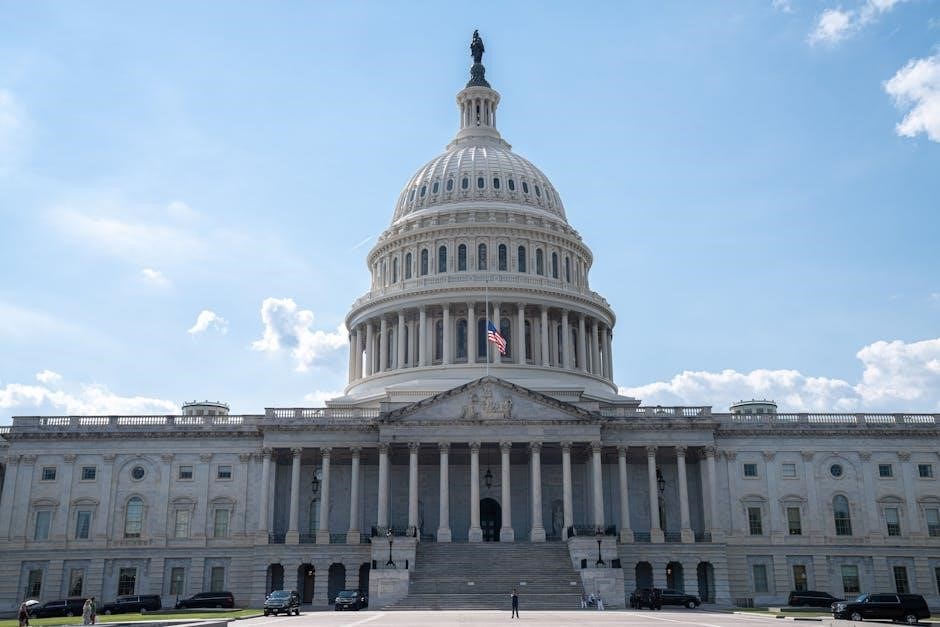the logic of american politics 11th edition pdf
This bestselling textbook provides a comprehensive analysis of American governance, offering insights into institutional design, civil rights, and political processes, with updates from the 2022 midterm elections.
1.1 Overview of the Book
The Logic of American Politics, 11th Edition, offers a detailed exploration of the U.S. political system, examining its historical foundations, institutional structures, and contemporary dynamics. The book delves into the Constitution, civil rights, and liberties, while also analyzing the roles of Congress, the executive branch, judiciary, and bureaucracy. It explores the influence of public opinion, political campaigns, parties, interest groups, and media on governance. With updated insights from the 2022 midterm elections, the text provides a toolkit of institutional design concepts, such as command, veto, and delegation, to help readers understand how the system operates. This edition is a valuable resource for students and scholars seeking to grasp the complexities of American politics.
1.2 Importance of Understanding American Politics
Understanding American politics is crucial for grasping the functioning of its institutions, policies, and societal impacts. The 11th Edition of The Logic of American Politics emphasizes the logic behind political processes, enabling readers to navigate the complexities of governance. In a time marked by polarization and shifting political landscapes, this knowledge empowers citizens to engage meaningfully in civic life. By exploring the historical and contemporary dynamics of American politics, the book provides essential insights for students, scholars, and anyone seeking to comprehend the nation’s political framework. Its analytical tools and real-world applications make it a vital resource for informed decision-making and critical thinking.
1.3 Target Audience and Purpose
The Logic of American Politics, 11th Edition, is primarily designed for undergraduate students in introductory American government courses. It serves as a foundational resource for scholars and enthusiasts seeking to understand the complexities of U.S. governance. The book’s purpose is to provide a clear, analytical framework for grasping political institutions, processes, and policies. By focusing on institutional design concepts, it equips readers with tools to critically evaluate how the political system operates. This edition is particularly valuable for those aiming to develop a deeper understanding of American politics, making it an essential text for both academic and personal enrichment.

Authors and Contributors
Samuel Kernell, Gary C. Jacobson, Thad Kousser, Lynn Vavreck, and Timothy Johnson are the renowned authors of the 11th Edition, bringing expertise from top universities like UCSD and UCLA.
2.1 Samuel Kernell, Gary C. Jacobson, Thad Kousser, Lynn Vavreck, and Timothy Johnson
Samuel Kernell, Gary C. Jacobson, Thad Kousser, Lynn Vavreck, and Timothy Johnson are the distinguished authors of the 11th Edition. Kernell, Jacobson, and Kousser are affiliated with the University of California, San Diego, while Vavreck is from UCLA, and Johnson from the University of Minnesota. Their expertise spans political institutions, civil rights, and electoral behavior. The book, published by CQ Press in 2023, is a 816-page paperback (ISBN: 978-1-07-186125-7). Their collaborative effort provides a detailed analysis of American governance, making it a vital resource for political science education. Their work is widely recognized for its clarity and depth in explaining complex political systems.
2.2 Contributions of Each Author
Samuel Kernell brings expertise in institutional design and political processes, while Gary C. Jacobson contributes insights on political parties and elections. Thad Kousser specializes in state and local politics, and Lynn Vavreck focuses on public opinion and campaign effects. Timothy Johnson provides analysis on the judiciary and constitutional law. Together, their diverse expertise ensures a comprehensive understanding of American governance, blending historical context with contemporary issues. Their collaborative approach offers students a balanced perspective on political dynamics, making the 11th Edition a valuable resource for political science education. Each author’s contributions enhance the book’s depth and relevance to modern political analysis.

Historical Background of the Constitution
The Constitution’s origins are rooted in the Founding Fathers’ vision, shaping a framework for governance that balances power and protects liberties, evolving over time to meet societal needs.
3.1 The Founding Fathers and Their Vision
The Founding Fathers, including figures like Madison, Jefferson, and Hamilton, sought to create a stable, representative government. Their vision emphasized federalism, checks and balances, and individual liberties. They designed a system to prevent tyranny, ensuring power was distributed among branches. The Constitution reflects their commitment to democratic principles, shaping America’s political framework. Their ideas continue to influence modern governance, as explored in the 11th Edition, which highlights the enduring relevance of their vision in understanding contemporary American politics and its institutional design.
3.2 Evolution of Civil Rights and Liberties
The 11th Edition explores the evolution of civil rights and liberties, tracing their development from the Constitution’s initial framework to modern interpretations. Key milestones include the Bill of Rights, Reconstruction-era amendments, and landmark Supreme Court decisions. The book highlights how civil rights expanded through the 13th, 14th, and 19th Amendments, ensuring equality and suffrage. It also examines the Civil Rights Act of 1964 and Voting Rights Act of 1965, which addressed racial discrimination. The text underscores the ongoing struggle for liberties, including recent debates on gender equality, LGBTQ+ rights, and voting access, illustrating the dynamic nature of American civil rights and liberties.

Forms and Functions of Government Branches
The book analyzes the structure and roles of Congress, the Executive branch, the Judiciary, and bureaucracy, explaining their functions and interactions in shaping American governance and policy.
4.1 Structure and Role of Congress
Congress is the cornerstone of American democracy, structured as a bicameral legislature with the House of Representatives and the Senate. The House, representing population, and the Senate, ensuring equal state representation, collectively shape laws. The book details Congress’s role in lawmaking, budget approval, and oversight of the Executive branch. It explores how Congress balances regional and national interests, emphasizing its critical function in reflecting public will while maintaining checks and balances in governance.
4.2 The Executive Branch and Its Powers
The Executive Branch, led by the President, is responsible for enforcing federal laws and serving as the nation’s commander-in-chief. The President also conducts foreign policy and negotiates treaties. Key powers include the ability to veto legislation and appoint federal judges and Cabinet members. The Vice President supports the President and assumes the role if the President is incapacitated. The Cabinet and administrative agencies carry out the day-to-day work of the Executive Branch. The book explains how these powers are exercised and balanced with Congress and the Judiciary, ensuring a system of checks and balances that maintains democratic governance and accountability.
4.3 The Judiciary and Its Impact
The Judiciary, led by the Supreme Court, plays a crucial role in interpreting laws and ensuring they align with the Constitution. Federal courts resolve disputes, and the Supreme Court has the final say on legal matters. Its decisions shape public policy, civil rights, and liberties, often influencing societal change. The Judiciary’s independence allows it to check the other branches, maintaining the balance of power. The book explores how judicial rulings impact governance, policy implementation, and individual freedoms, highlighting the Judiciary’s role in upholding the rule of law and its profound effects on American political dynamics and public opinion.
4.4 The Bureaucracy in Modern Governance
The bureaucracy serves as a cornerstone of modern governance, responsible for implementing policies, regulating activities, and delivering public services. It operates within a complex framework, balancing political oversight and administrative autonomy. The 11th edition highlights how bureaucratic agencies navigate these challenges, ensuring efficient governance while addressing public needs. The book explores the bureaucracy’s role in policy execution, its interaction with Congress and the Executive Branch, and its impact on societal well-being. Despite criticisms of inefficiency and political influence, the bureaucracy remains essential for translating legislative and executive decisions into actionable programs, demonstrating its critical role in maintaining the functionality of American democracy.

Influence of Public Opinion and Political Campaigns
Public opinion significantly shapes policy decisions, while political campaigns play a crucial role in elections, influencing governance and voter representation in American politics.
5.1 How Public Opinion Shapes Policy
Public opinion serves as a cornerstone of democratic governance, directly influencing policy decisions. Elected officials often align their actions with prevailing sentiments to maintain voter support. The 11th edition highlights how public opinion, measured through polls and elections, shapes legislative agendas and executive decisions. It emphasizes that policymakers prioritize issues reflecting majority views, ensuring representation. Additionally, political parties and interest groups amplify specific opinions, further steering policy directions. This dynamic ensures that governance remains responsive to societal needs, illustrating the profound impact of public sentiment on the American political landscape.
5.2 The Role of Political Campaigns in Elections
Political campaigns play a pivotal role in shaping election outcomes by influencing voter decisions and setting the agenda. The 11th edition explores how campaigns use strategic messaging, voter targeting, and financial resources to sway public opinion. It highlights the importance of campaign finance, media coverage, and grassroots mobilization in determining electoral success. The book also examines how campaigns reflect and amplify partisan divisions, contributing to political polarization. By analyzing these dynamics, the text underscores the critical function of campaigns in democratic processes, emphasizing their impact on representation and governance. This section provides a detailed understanding of how campaigns operate and their broader implications for American politics.

Political Parties and Interest Groups
Political parties and interest groups shape policy and elections by representing diverse interests, influencing voter behavior, and advocating for specific agendas, as detailed in the 11th edition.
6.1 Functions of Political Parties
Political parties play a crucial role in simplifying voter choices, organizing government, and holding elected officials accountable. They represent diverse ideologies, mobilize support, and shape policy agendas. By aligning with specific platforms, parties help voters make informed decisions and ensure accountability in governance. Additionally, they provide a framework for political competition, fostering debate and representation of varied interests. The 11th edition highlights how parties adapt to changing voter preferences and societal needs, ensuring their relevance in modern American politics. Their functions are essential for maintaining democratic processes and facilitating effective governance.
6.2 Impact of Interest Groups on Legislation
Interest groups significantly influence legislation by advocating for specific policies that align with their agendas. Through lobbying, campaign contributions, and public advocacy, these groups shape political outcomes. The 11th edition highlights how their efforts can sway lawmakers, often leading to policies that benefit particular sectors or ideologies. While they provide a voice for diverse interests, their impact can also lead to inequality in representation. The book emphasizes how the influence of interest groups reflects both the strengths and challenges of American democracy, where organized interests often play a pivotal role in shaping legislative decisions and public policy outcomes.

The Media’s Role in American Politics
The media significantly influences public perception and political outcomes, shaping opinions through coverage and framing issues. Its evolution impacts how information is disseminated and consumed in modern governance.
7.1 Media Influence on Public Perception
The media plays a pivotal role in shaping public perception of American politics. Through selective coverage and framing, it influences opinions on policies, candidates, and institutions. The evolution of media, from traditional outlets to digital platforms, has transformed how information is disseminated. This shift impacts political engagement and polarization, as highlighted in the 11th edition. The book emphasizes how media narratives can amplify certain issues while marginalizing others, thereby swaying public sentiment. Understanding this dynamic is crucial for grasping the interconnectedness of media, politics, and governance in contemporary society.
7.2 The Evolution of Media in Politics
The media’s role in politics has undergone significant transformation, evolving from traditional print and broadcast outlets to digital platforms. This shift has reshaped how political information is disseminated and consumed. The 11th edition highlights how digital media has increased accessibility but also amplified polarization. Social media platforms, in particular, have become central to political discourse, enabling real-time engagement but also spreading misinformation. This evolution challenges traditional journalistic norms and raises questions about the credibility of sources. The book underscores the importance of understanding these changes to navigate the complexities of modern political communication effectively.

Federal and State Government Interactions
The book examines the dynamic interplay between federal and state governments, focusing on power distribution, policy implementation, and collaborative efforts, highlighting their shared responsibilities in governance and public services.
8.1 Overview of Federalism
Federalism is a cornerstone of the U.S. political system, dividing power between federal and state governments. The 11th Edition explores how this system balances national unity with state autonomy, ensuring localized governance while maintaining federal authority. It examines the constitutional framework, the evolution of federal-state relations, and the practical implications of shared responsibilities. The book highlights how federalism addresses diverse regional needs while preserving national cohesion, providing a foundational understanding of this critical aspect of American governance.
8.2 Omissions in the Book Regarding State-Federal Relations
The 11th Edition of The Logic of American Politics does not include a dedicated chapter on interactions between federal and state governments, which some readers may view as a notable omission. While the book covers federalism and the constitutional framework, it does not delve deeply into specific challenges or dynamics of state-federal relations, such as cooperative federalism or contemporary conflicts. This lack of detailed analysis may limit its utility for readers seeking a comprehensive understanding of how these two levels of government interact in practice. Despite this, the book remains a valuable resource for broader insights into American governance.
The 11th Edition Updates and Features
The 11th Edition features fresh analysis of the 2022 midterm elections, offering new insights and updated tools for understanding American governance and its current dynamics.
9.1 Key Updates in the 11th Edition
The 11th Edition of The Logic of American Politics includes fresh analysis of the 2022 midterm elections, providing new insights into political polarization and governance. It introduces updated institutional design concepts, such as command, veto, and agenda control, to help students understand the complexities of the American political system. The edition also expands on civil rights and liberties, reflecting contemporary legal and social developments. Additionally, it incorporates the latest data and events, ensuring a timely and relevant exploration of American politics. These updates enhance the textbook’s ability to equip students with essential tools for analyzing current political dynamics and institutional interactions.
9.2 New Insights from the 2022 Midterm Elections
The 11th Edition incorporates fresh analysis of the 2022 midterm elections, offering new perspectives on political polarization, voter behavior, and the impact of campaign strategies. It examines how these elections reflected shifting public opinion and partisan divides, providing students with a deeper understanding of contemporary political dynamics. The book highlights key trends, such as the role of misinformation and the influence of external factors on election outcomes. These insights are integrated into the broader framework of institutional design, enabling readers to connect electoral results with governance structures and policy outcomes. This update ensures the text remains relevant and aligned with current political realities.

Accessing the Book
The 11th Edition is available in PDF, eBook, and paperback formats. Published by CQ Press, it can be purchased on Amazon, eBook platforms, or directly from the publisher. ISBN: 978-1-07-186125-7.
10.1 Availability of the 11th Edition in PDF Format
The 11th Edition of The Logic of American Politics is widely available in PDF format. It can be purchased directly from CQ Press or platforms like Amazon and eBook stores. Some users have reported finding free PDF versions online, though authenticity and legality should be verified. The PDF version is convenient for digital access and is compatible with all major devices. ISBN: 978-1-07-186125-7. Ensure the PDF is labeled as the 11th Edition, as some sources may misidentify the version. This format is ideal for students and researchers seeking portability and easy access to the textbook’s insights on American governance and political dynamics.
10.2 Purchase Options and Platforms
The 11th Edition of The Logic of American Politics in PDF format can be purchased through various platforms. Official sources include CQ Press, Amazon, and Barnes & Noble. eBook platforms like Google Books and Apple Books also offer the PDF version. Additionally, some academic websites and online marketplaces provide access. Ensure to verify the ISBN (978-1-07-186125-7) for authenticity. Payment options typically include credit cards and PayPal. The PDF is available for immediate download post-purchase, making it a convenient option for students and researchers. Note that access codes for supplementary materials may not be included with the PDF purchase.

Educational Value and Tools
The 11th Edition offers institutional design concepts and analytical tools, enabling students to understand governance structures and political processes effectively through real-world applications and updated insights.
11.1 Institutional Design Concepts Explained
The 11th Edition elaborates on institutional design concepts like command, veto, agenda control, and delegation, providing a framework to analyze how political systems are structured and function. These tools enable students to understand the intentional design of American governance, linking historical and contemporary practices. By focusing on these concepts, the book helps readers comprehend the logic behind political institutions and their interactions. This analytical approach equips students with a deeper understanding of how power is distributed and exercised within the system, making complex political dynamics more accessible and understandable through practical examples and real-world applications.
11.2 Analytical Tools for Understanding Governance
The 11th Edition provides robust analytical tools to decipher governance, emphasizing concepts like veto power, agenda control, and voting rules. These tools empower students to critically assess political dynamics, tracing historical roots to modern applications. By integrating real-world examples, the text bridges theory and practice, offering insights into institutional interactions. The updated content, including 2022 midterm election analysis, enhances the relevance of these tools, enabling a deeper comprehension of governance structures and their evolution over time. This analytical framework equips readers with the skills to evaluate complex political systems effectively, fostering a nuanced understanding of American politics and its foundational principles.
The Logic of American Politics 11th Edition offers a foundational understanding of governance, equipping students with analytical tools to navigate the complexities of American political dynamics effectively.
12.1 Summary of Key Points
The 11th Edition of The Logic of American Politics provides a detailed exploration of American governance, covering the Constitution, civil rights, and the structure of government branches. It examines the influence of public opinion, political campaigns, parties, and interest groups, while also addressing the role of the media. The book includes updated insights from the 2022 midterm elections, offering a contemporary perspective on political dynamics. By focusing on institutional design concepts, it equips readers with tools to understand the logic behind American political processes. This edition is a valuable resource for students and scholars seeking to grasp the complexities of U.S. politics.
12.2 Final Thoughts on the Book’s Relevance
The Logic of American Politics, 11th Edition remains a foundational resource for understanding U.S. governance. Its comprehensive analysis of political institutions, civil rights, and electoral dynamics provides invaluable insights for students and scholars. The inclusion of the 2022 midterm elections ensures relevance in today’s polarized political landscape. The book’s focus on institutional design and analytical tools makes it a practical guide for grasping complex political processes. With its balanced approach to theory and real-world application, it serves as an essential text for anyone seeking to comprehend the intricacies of American politics. Its availability in PDF format further enhances accessibility for modern learners.










Leave a Comment